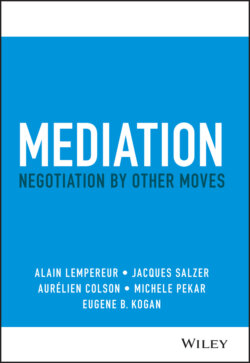Читать книгу Mediation - Alain Lempereur - Страница 11
The Other
ОглавлениеFaced with conflict and rejecting the presence of an external authority does not necessarily mean that individually each party has full power to shape the outcome. The parties need to work together, and their cooperation constitutes an inescapable variable in the equation: as much as the parties are part of the problem, they are also part of the solution. Each party cannot ignore the other, just as the other cannot ignore them. Each owns a part of the story, likely contributed to what happened, and is therefore asked to feel responsible for overcoming the conflict.
This is why “the other” constitutes a fundamental theme in this book. In fact, putting the other at the heart of the exchange is essential for
each of the parties in conflict, who can develop empathy toward the other, i.e. put themselves in the other's shoes, so that both sides engage back and forth in a double move toward mutual understanding, where (i) each understands the other better and (ii) each is better understood by the other;
the mediator, who, instead of seizing ownership of the conflict, preserves both parties' control of their conflict and its resolution, through reciprocal recognition of the “two others” and hopefully by each other.
The mediator plays an intermediary role between the two “others.” The centrality of the other is evoked in the
past, a time of conflict, ignorance, or condemnation of the other, with different perceptions and opposing visions of “this” radically different other, separation and alienation from the other, creation of negative otherness;
present, a time of mediation, which facilitates a dialogue between the two estranged others, allowing them to analyze the similarities and differences between them in their narratives, in order to foster a mutual recognition of identities and needs, where each “other” might come back in renewed proximity with one another, and where this possible restored link builds some readiness to explore solutions;
future, which may still be uncertain but which can be built together by creating a common ground for a renewed relationship, one where the other is not simply present with me, but where the other sees themselves as having a future with me in it.
Integrating the other happens through deepening understanding, which requires active perceiving, i.e. a methodical use of listening and looking, and probing – which everyone thinks they practice well, but which can often be improved. The mediator's display of skilled understanding of the two parties is often the platform that enables both of them to understand each other.
